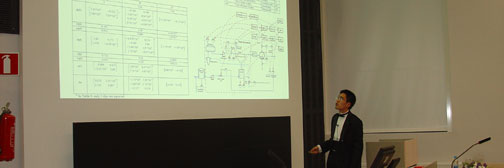| |
Further reducing environmental impacts such as the reduced-sulfur emissions will be among the major challenges facing the pulp and paper industry in the near future. It will not be easy to further decrease the emissions at modern pulp mills because all the major emission sources have already been eliminated. New strategies, such as the prevention of emissions at their source, e.g. by means of improved control of the subsequent processes, will therefore undoubtedly be required in order to conform with the present and also future environmental requirements. An increase in authorities and also public attention and awareness on environmental issues together with intensifying interest in the artificial intelligence (AI) and intelligent systems were also prime motivator for this thesis work.
The primary objective of the research, which has been carried out as a co-operative effort between academic and industrial parties, has been to lower of the total reduced-sulfur (TRS) emissions from a pulp mill by means of intelligent control techniques. The research was focused on the lime reburning process, which is one of the main sources of the TRS emissions at modern pulp mills. In addition, the environmental requirements for lime kilns have become tighter and even at well-managed mills, the emissions tend periodically to exceed the limits set by the authorities. It has also been widely recognized that control of the rotary kiln used for lime calcination is, in many respects, a demanding task. So far, most of the kilns have therefore been operated without supervisory-level control system. However, there are outstanding economical and the environmental improvement potentials associated with improved control. Hence, supervisory-level control of the lime reburning process is undoubtedly a prospective application for intelligent control techniques.
In the first phase of the research, a comprehensive study of the operation of the lime reburning process was carried out at one of the major Finnish pulp mills, with special attention paid to the factors affecting the TRS emissions. The results showed that, in addition to the considerable enhancement potential in the performance of the kiln process operation, improved kiln control is also a feasible means to reduce emissions. An overall supervisory-level control schema that takes into account both the environmental and operational requirements, was then designed on the basis of the results of the study. The supervisory-level control system, embedded with a certain degree of intelligence, was then incrementally developed and implemented at the pulp mill. The control structure combines both feed forward (FF) control models and supervisory-level feedback (FB) controllers that are based on the linguistic equation (LE) approach, strengthened with certain capabilities for adaptation and constraint handling. Advanced capabilities and highly developed functionality of the control system were achieved by combining information from different knowledge sources, and by using appropriate techniques to solve each of the recognized problems. On the other hand, the complexity of the lime reburning process was handled by implementing a modular system structure and by taking advantage of an incremental system development approach.
The results obtained during extended testing periods of the system demonstrate that the proposed control schema can be successfully realized in an industrial environment, and that it also provides quantifiable benefits in both the economical and ecological respect. The major benefit from the ecological point of the view was an almost 30 % decrease in the mean of the TRS emissions and a considerable reduction, about 90 %, in the proportion of high emissions periods. The main verified economical benefits were an increase of about 5 % in the long-term production capacity. Improvements in reburned lime quality and enhancements in the energy efficiency were also obtained compared to the situation during manual operation.
Thesis electronical version can be downloaded from here
This info last modified 28 Apr 2024 by Jerri Kämpe-Hellenius
|



